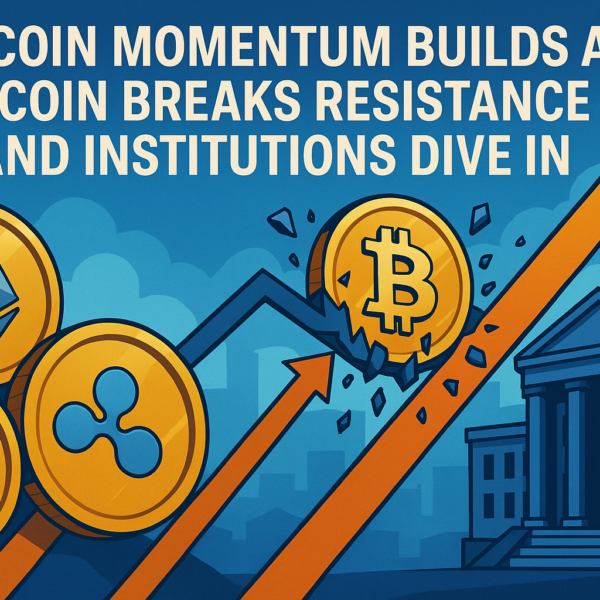BlackRock Launches Bitcoin ETP After UK Lifts Trading Ban
When traditional finance begins to adopt Bitcoin, it signals a critical turning point that contrarian investors should not ignore. The recent unveiling of a Bitcoin Exchange-Traded Product (ETP) by BlackRock — the largest asset management firm in the world — marks more than just another crypto fund launch. It coincides with a monumental shift in the stance of the UK’s Financial Conduct Authority (FCA), which has recently reversed its nearly three-year ban on the sale of crypto-linked securities to retail investors. This confluence of regulatory change and institutional action is not merely notable — it’s a potential inflection point in the adoption cycle of Bitcoin on a global scale.
For seasoned investors who understand the cyclical nature of financial markets, this is more than just encouraging news. It’s a powerful signal. While the mainstream media hails moves like BlackRock’s as the official “legitimization” of crypto assets, those with a contrarian mindset see through the surface. The significance is far deeper: Institutional adoption of Bitcoin is surging into territories where only skepticism existed before, and Europe — long seen as a regulatory fortress — is now opening its gates.
FCA Reversal: Regulatory Resistance Gives Way to Market Forces
In January 2021, the FCA implemented a ban on the sale of crypto derivatives and ETPs to retail investors, citing concerns about price volatility, fraud, and lack of a clear valuation basis. This action effectively drove a wedge between UK retail investors and access to Bitcoin through traditional financial instruments. At the time, the move was seen by some as a protective measure, but for many, it signaled the UK’s hesitance or even unwillingness to innovate alongside the rapidly evolving digital asset industry.
Fast forward nearly three years, and that wall is beginning to crumble. The FCA’s recent policy shift doesn’t just signal a change in regulatory tone — it’s indicative of a broader re-evaluation happening across Western financial institutions. In a world more attuned to inflationary pressures, de-dollarization, and geopolitical instability, digital assets are no longer viewed solely as high-risk speculation. They’re increasingly seen as potential hedges, alternative stores of value, and instruments that can enhance portfolio diversification.
The reversal also reflects intensifying global competition for crypto innovation. As jurisdictions like Switzerland, Singapore, and parts of the U.S. embrace blockchain and digital assets, policymakers in the UK are realizing that overregulation may hinder future financial competitiveness. BlackRock’s strategic entry into the UK market with a Bitcoin product — timed with this new regulatory landscape — is not happenstance. It is a move of intentionality. A whisper, perhaps, but one that echoes loudly for those who know what to listen for. It is, in many ways, a form of regulatory capitulation disguised as policy evolution.
BlackRock’s ETP: The Institutional Playbook in Motion
BlackRock isn’t known for speculative plays. This is a firm with over $10 trillion in assets under management (AUM), and its product pipeline is tuned for long-term value creation and capital preservation rather than hype cycles. So when BlackRock launches a Bitcoin ETP in the UK — far away from the speculative Wild West narrative of some crypto exchanges — it represents a seismic shift in how the wealthiest fiduciaries and asset allocators view Bitcoin’s place in diversified portfolios.
Products like ETPs provide regulated, structured, and insured exposure to Bitcoin — solving several pain points that institutions have faced for years. Custody, regulatory compliance, and reporting simplicity have all been barriers to entry for traditional firms wanting digital asset exposure. With BlackRock removing those hurdles, this new offering gives pension funds, endowments, family offices, corporate treasuries, and other institutional players a sanctioned pathway to Bitcoin allocation without the need to directly buy or hold the asset themselves.
What we’re witnessing is not a retail-fueled rally driven by NFT mania or dog-themed altcoins. This is institutional capital beginning to test the digital waters — and they always test before they flood. The deliberate and tentative approach of these capital allocators should not be mistaken for indifference. It’s strategic caution. And those with foresight will understand that the smart money is already entering the arena — not when Bitcoin breaks all-time highs, but now, quietly, before the crowd joins in.
Strategic Positioning: A Contrarian Investor’s Roadmap
Events like these create a unique window of opportunity. With institutional flows beginning to form and regulators opening access, the landscape is shifting. For contrarian investors with a long-term view, the time to accumulate and position is now — before the market fully absorbs what this institutional acceptance represents.
- Buy spot Bitcoin pre-ETP wave — While retail may jump in during hype cycles, contrarians should accumulate before inflows from ETPs begin to exert consistent upward pressure on price.
- Identify UK-based crypto platforms poised for regulatory compliance — Look for exchanges, custody providers, or fintechs that are updating their offerings in line with the FCA’s latest stance. These companies may be first in line to capture retail and institutional demand alike.
- Explore second-layer opportunities — Bitcoin miners, infrastructure providers, and financial service companies operating in compliance-friendly jurisdictions are likely to benefit from the increasing institutional interest in Bitcoin, both as users and as investable entities.
There’s a level of inevitability in Bitcoin’s path that regulators and institutions are slowly beginning to recognize. However, their entry isn’t guided by philosophical belief in decentralization or monetary policy reform. It’s driven by necessity. Asset allocators are staring down a new financial era marked by inflation, rising interest rates, and eroding trust in fiat systems. Bitcoin, with its predictable issuance and censorship-resistant structure, is becoming an alternative worth hedging into — not just for ideological believers, but for the most conservative pension boardrooms, too.
The Beginning of the End for Skepticism
For the past decade, skeptics have dismissed Bitcoin as a fringe movement. Media narratives varied from “it’s a bubble” to “it’s used for crime” to “it consumes too much energy.” Each wave of criticisms attempted to erect obstacles between Bitcoin and widespread acceptance. But the needle has moved — and sharply.
One by one, legacy institutions are coming onboard. In the United States, Bitcoin ETFs have attracted billions in inflows within months of approval. In Asia, sovereign funds are exploring tokenization and blockchain asset rails. Europe, long trailing behind, is now knocking at the door of the digital frontier. What BlackRock’s entrance into the UK market represents is more than new access — it symbolizes the collapse of an old guard’s resistance to the digital age.
Smart investors understand that value accrues not when adoption reaches its peak, but when infrastructure begins to lay the groundwork for that peak. Right now, we’re in the foundation-laying phase — where regulatory frameworks are catching up, institutions are preparing offerings, and markets are still seeded with reasonable entry points.
Conclusion: The Time to Act Is Before the Masses Arrive
To many, BlackRock’s Bitcoin ETP and the FCA’s regulatory reversal may come across as delayed acknowledgments of digital assets’ relevance. But for the contrarian investor, these are sirens signaling early adoption by serious capital. The gates of institutional finance are slowly opening to the decentralized world, and those who recognize the ripple effects of that trend now stand to benefit disproportionately.
Timing, as always, is the edge. Once headlines scream about Bitcoin breaking new highs or legacy banks offering BTC services en masse, the window for asymmetric upside will have started to close. The gate has cracked — and now is the moment to walk through it.












